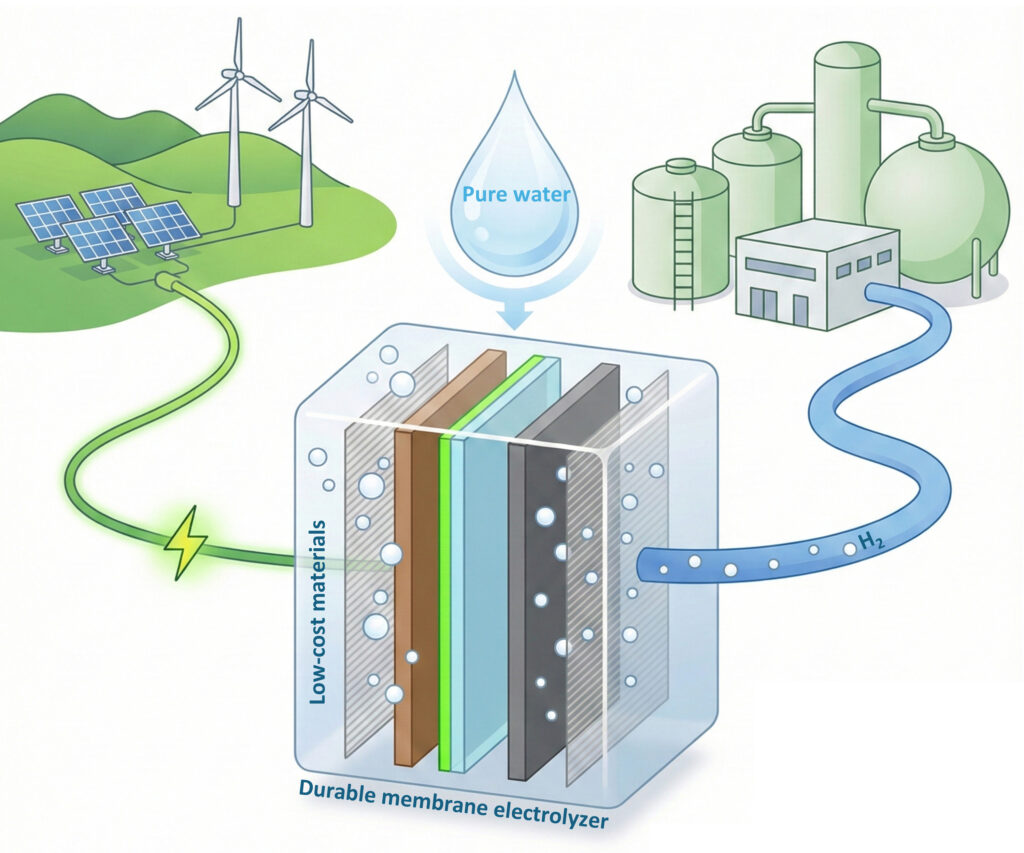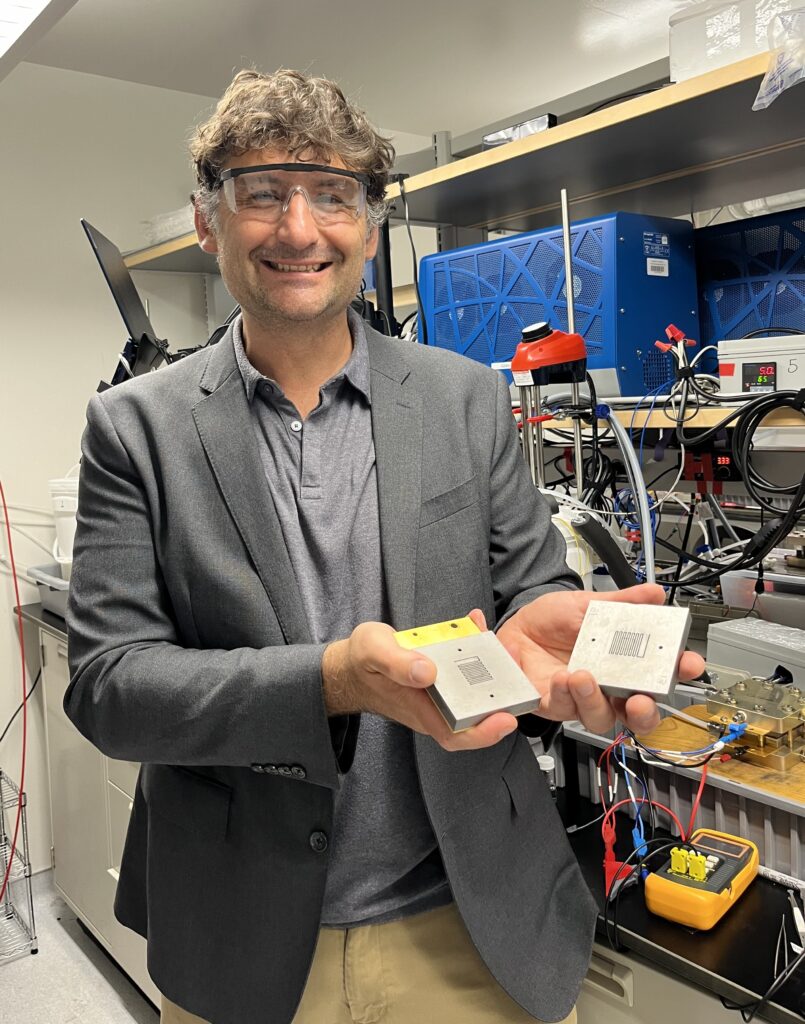A University of California, Berkeley chemist has engineered a new technology that could make hydrogen-producing fuel cells last longer and hasten the arrival of cost-competitive, eco-friendly versions of the fuel source.
Hydrogen is used as a fuel for heavy transport vehicles, a chemical feedstock for fertilizer and other chemical and materials production, and a solution for long-duration energy storage on the electrical grid. Today, most hydrogen is produced from natural gas and, to a lesser extent, coal, releasing large amounts of carbon dioxide and carrying the typical environmental impacts of fossil fuel extraction and use.
Hydrogen can also be made by electrolyzers that split water and emit only oxygen gas as a byproduct. But for most applications, hydrogen from water electrolysis is currently too expensive to compete with fossil sources without subsidies. The solution is to use cheap but intermittent wind and solar to provide the electricity, but to do that, the electrolyzers themselves must cost less to manufacture because of the lower fraction of time they are in use.
Shannon Boettcher and his team are developing a new electrolysis technology that uses ion-conducting polymers that could dramatically lower cost, but so far, they haven't been stable enough - the electrodes tend to degrade quickly. His team has now redesigned these electrolyzers in a way that protects the electrodes from degradation.
"If you can make this really work, it's not unreasonable to expect a 5x or 10x reduction in the cost of these membrane electrolyzers, which would truly enable us to put them on the grid as a variable-load offtake of low-cost electrons and deliver hydrogen," said Boettcher, a UC Berkeley professor of chemical and biomolecular engineering and of chemistry.
Electrolyzers are a way to take excess energy generated during peak periods for solar and wind and convert it to hydrogen for later use, both for industry and even for seasonal electrical storage.
"We're trying to develop electrochemical technologies for making hydrogen that can take advantage of all that intermittent electricity," Boettcher said.
Boettcher and his colleagues published their findings Oct. 16 in the journal Science.
Why batteries die
According to Boettcher, degradation of the polymer electrodes, where electrons are extracted from hydroxide ions (OH–) to make oxygen gas, occurs when the polymers themselves lose some of their electrons. This oxidative degradation is the major challenge in making this electrolyzer technology commercially competitive. Although the team's work to solve this issue was funded by the U.S. Department of Energy, the grant was abruptly terminated during the recent shutdown. UC Berkeley is disputing the termination.

Yang Zhao/UC Berkeley
There are two major commercial electrolyzer types, Boettcher said. Liquid alkaline electrolysis uses a hot, caustic solution, similar to the Drano used to unclog drains, as the ion conducting liquid electrolyte surrounding the electrodes and a porous ceramic interface to keep the hydrogen and oxygen gas separate. While these devices are fairly efficient and being scaled in size broadly in China, the Drano-like electrolyte makes maintenance difficult and the ceramic separators don't work as well at high rates of hydrogen production or with intermittent operation.
A newer alternative is a proton exchange membrane electrolyzer, which has an acidic ion-conducting organic polymer membrane that serves as the electrolyte and also keeps the oxygen and hydrogen gases apart.
"This electrolyzer is beautiful because the membrane blocks to a much larger extent the oxygen and hydrogen from mixing across this membrane," he said. "You can get the two electrodes very close together and make hydrogen at one electrode at high efficiency, oxygen at the other electrode at high efficiency, and the membrane is the electrolyte - the salt solution - but it's a solid so you only need to feed it pure water."
Here, though, the strongly acidic environment inside the electrolyzer cell is the problem.
"Strong acids dissolve almost every metal we know under oxidation conditions - conditions where you make oxygen, which you have in this electrolyzer," he said. The only viable electrode is made from the expensive metal iridium, and the electrolyzers also require so-called forever chemicals, fluorocarbons, to make the polymer stable.
Boettcher's new technology, called an anion-exchange-membrane water electrolyzer, combines the advantages of a solid polymer membrane with the efficiency and cheapness of the simple caustic or alkaline electrolyte.
"You can get all the low-cost material advantages of one technology - the alkaline technology - with all the advantages of the membrane technology, including lower cost, higher safety and less maintenance, but to do that they need to be durable," he said
To solve the problem of degradation, Boettcher focused on the anode electrode - where oxidation takes place - because that is where the most damage occurs. The positive charge of the electrode pulls electrons off the polymer molecules, which speeds the rate at which hydroxide ions eat away the polymer.
"One of the ways batteries die is also because of side reactions like this," he said. "The electrons in the battery material end up reacting with the electrolyte, you have these unwanted side reactions, it gums up your battery, your battery stops working."
Inspired by decades of work by others to improve batteries, Boettcher and his team devised a way to protect the polymer from side reactions. This involves mixing an inexpensive ingredient, a zirconium oxide inorganic polymer, with the organic polymer that conducts the ions and separates the gases. The zirconium polymers build up around the anode electrode and create a "passivation" layer that protects the more-sensitive organic polymer from losing electrons when the oxygen is made.
"We get a hundred times decrease in the degradation rate," he said. "We're not all the way there (to a commercially viable electrolyzer), but this is by far the biggest knob we've found to get there."
Electrochemistry Academy
The anode is made by depositing a cobalt-based catalyst onto a steel wire mesh and then completely covering the catalyst and mesh with the polymer mix. The negative electrode or cathode, which pulls hydrogen ions from water to make the hydrogen, is then added, forming a sandwich.

Yifan Wu/UC Berkeley
Boettcher, who holds the Theodore Vermeulen Chair in Chemical Engineering, continues work to understand and improve electrode performance and eliminate all the remaining degradation modes. He is also the founding director of the Center for Electrochemical Science, Engineering and Technology (CESET) at UC Berkeley.
He hopes that improved electrolyzers and other new battery technology will get a boost from a $28 million investment California made in September to accelerate the commercialization of electrochemical technologies, with an initial focus on next-generation batteries. The California Energy Commission awarded the money to the Electrochemistry Foundry in Hayward, a privately operated, non-profit innovation hub designed to pilot and scale up new electrochemical technology. UC Berkeley is introducing new courses in batteries and other electrochemical technologies through its new Electrochemistry Academy and partnering with the foundry to provide internship opportunities for students.
"Hydrogen production, storage, shipping - they're all expensive and there's a lot of challenges. But the progress in this technology is incredible," Boettcher said. "The era of hydrogen fuel from electrolysis outcompeting fossil fuels without subsidy for many different applications is coming."
The work was funded by the U.S. Department of Energy (DE-EE0011322). Coauthors include Shujin Hou, Yang Zhao, Minkyoung Kwak, Kelvin Kam-Yun Li, Peiyao Wu, Anthony Ekennia and Joelle Frechette of UC Berkeley and Gregory Su of Berkeley Lab along with collaborators at Versogen, a Delaware based company working to commercialize the technology, the University of Delaware and Stanford.






